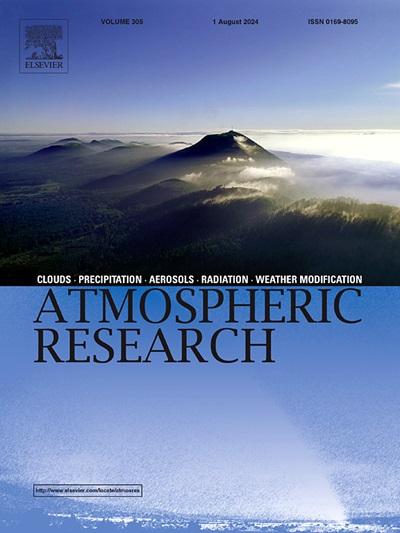Sources and light absorption of brown carbon in urban areas of the Sichuan Basin, China: Contribution from biomass burning and secondary formation
IF 4.5
2区 地球科学
Q1 METEOROLOGY & ATMOSPHERIC SCIENCES
引用次数: 0
Abstract
The optical properties of brown carbon (BrC) and their correlation with chemical characteristics remained inadequately understood in different regions worldwide. This study investigated the correlations and estimated the subsequent radiative effects using real-time measurements during wintertime in the Sichuan Basin, China. The average light absorption of BrC (AbsBrC) at 370 nm constituted 35.5 ± 8.2 % of total absorption, significantly higher than those at 470 nm (20.9 ± 4.3 %), 590 nm (14.0 ± 2.5 %), and 660 nm (7.7 ± 2.1 %) (p < 0.001). The contributions of various organic aerosol (OA) sources to AbsBrC varied by wavelength, with biomass-burning OA (BBOA) and semi-volatile oxygenated OA (SVOOA) exhibiting the higher Abs (14.4 Mm−1 and 13.5 Mm−1), absorption Ångström exponents (AAE) (4.81 and 4.35), and contributions to AbsBrC (24.4 % and 22.8 %). Additionally, secondary BrC likely formed from BBOA through aqueous-phase reactions during winter. The transport of BBOA and SVOOA from northern regions (i.e., Guang'an in Sichuan and Hechuan in Chongqing) significantly contributed to elevated Abs370,BrC levels. The mean simple forcing efficiency for BrC (SFEBrC) was 60.5 W g−1, accounting for 14 % of SFEBC in the 370–880 nm range during winter. Overall, this study enhanced the understanding of AbsBrC and its evolution with sources, providing a more accurate assessment of its radiative effects, and emphasized the importance of biomass burning emissions.
求助全文
约1分钟内获得全文
求助全文
来源期刊

Atmospheric Research
地学-气象与大气科学
CiteScore
9.40
自引率
10.90%
发文量
460
审稿时长
47 days
期刊介绍:
The journal publishes scientific papers (research papers, review articles, letters and notes) dealing with the part of the atmosphere where meteorological events occur. Attention is given to all processes extending from the earth surface to the tropopause, but special emphasis continues to be devoted to the physics of clouds, mesoscale meteorology and air pollution, i.e. atmospheric aerosols; microphysical processes; cloud dynamics and thermodynamics; numerical simulation, climatology, climate change and weather modification.
 求助内容:
求助内容: 应助结果提醒方式:
应助结果提醒方式:


